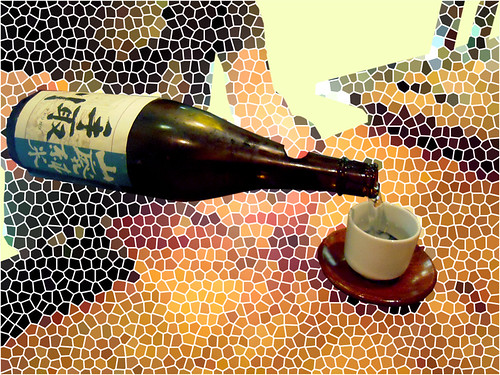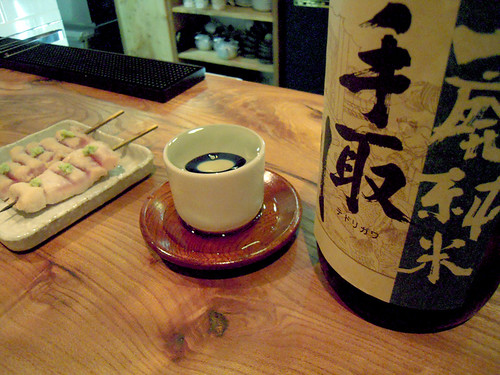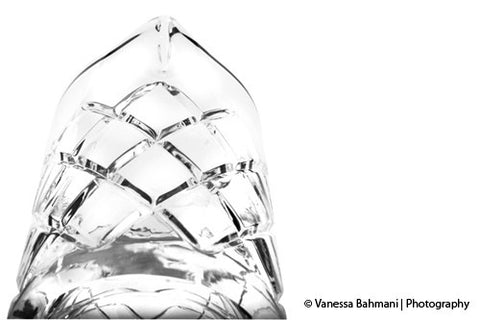
I had many opportunities during my first six months living in Japan to get really unpleasant hangovers from sake. This was mainly because I was living off a wage that made me think "Did I miss my stop and end up in China?" while drinking a lot of cheap sake. Nevertheless, the job was awesome--I worked at
Design Festa in Ura-Harajuku and drank my poor-girl troubles away with co-workers at the nearby AM/PM nearly every night.
That's when I started drinking my way into the complex world of
nihonshu (sake). Sake means "alcohol" in Japanese and their word for the English term "sake" is nihonshu (Nihon = Japan; Shu = Alcohol).
What constitutes the classification of
futsushu (ordinary sake) versus
tokutei meishoshu (premium sake) is its
seimaibuai (rice polishing ratio). When preparing rice for the sake-brewing process, the rice must be polished down. This is because the outer layers with fats and oils that would otherwise disturb the taste of the sake should be eliminated. There is no set ratio for futsushu, but tokutei meishoshu (premium sake) must use rice that has been polished down at least 30% for a seimaibuai of 70% or less.
FUTSUSHU
The sake I drank out of paper cartons* during my AM/PM
conbini (convenience store) days are considered futsushu (Futsu = Ordinary; Shu = Alcohol). The sake market is comprised of about 70-75% futsushu. Futsushu is like the
Charles Shaw of sake--it is affordable, fairly good, ideal for cooking and may give you a horrible hangover the next day if you drink too much.
Most people in the states encounter futsushu at cheaper sushi places that serve their sake really hot. And more often than not the sake is dispensed out of an apparatus which allows the sake bottle to be cradled upside down for easy serving.
Looser restrictions on futsushu means that a larger amount of brewer's alcohol along with sugars and organic acids can be added to pump up the yeild.
Here is a futsushu brand I remember, MARU, from my poor-girl days.
http://www.youtube.com/watch?v=dabweerwaxY
*
Junmai (rice sake with no distilled alcohol added) and other premium sakes are packaged in paper cartons as well, so it can't be assumed that all sake packaged in paper cartons are of ordinary grade.
TOKUTEI MEISHOSHU
Chances are that many people reading are way beyond this discussion and are only concerned with tokutei meishoshu (premium sake) which includes Junmai,
Honjozo, Ginjo and
Daiginjo--the kinds of sake that you would encounter in more upscale restaurants and bars. But before I dive into the descriptions for each of these (which I will next week, but for now, check out
this chart on Wiki for some clarification), I feel it is necessary to define tokutei meishoshu as a whole.
As mentioned in the futsushu section, what distinguishes ordinary from premium sake is the rice polishing ratio. Premium sake must use rice that has been polished down to at least 70% its original size. This requirement results in premium sake having a smoother taste with less roughness that sometimes resides in the outer layers of the rice.
It's difficult and impossible to describe the taste characteristics of tokutei meishoshu as a whole since the range is extremely wide. But on a menu or on the shelves, the best indicator of how any tokutei meishoshu distinguishes itself from futsushu is its price. So keep your eyes peeled on the dollar sign.
I went to
IPPUKU in Berkeley last night to try an example of a tokutei meishoshu and here's what I got. FYI, IPPUKU does not carry any futsushu.
Tedorigawa Yamahai Junmai Sake.

This example of tokutei meishoshu happens to be a junmai sake. Tedorigawa, with a seimaibuai of 60% and alcohol content of 15.8% was bold and smooth. IPPUKU's bartender Washi describes it as, "A chardonnay with umami." Indeed, there was a depth in the Tedorigawa that was absent from my second order, the Chikurin Fukawari (another junmai).
LESSON SUMMARY FOR FUTSUSHU VS. TOKUTEI MEISHOSHU
The following is a chart that includes some generalizations so please understand that it is possible to enjoy a wonderful futsushu, chilled. It's always smart and amusing to read the labels and see what the manufacturer recommends. But ultimately, it's all you, so taste pensively and deliberate with you and your drinking buds.
| Type of Sake |
Futsushu |
Tokutei meishoshu |
| English |
Ordinary |
Premium |
| Seimaibuai |
No restriction |
at least 70% |
| Temperature |
Hot (with exceptions) |
Chilled, room temp, hot |
| Ideal for |
Cooking, drinking |
Drinking |
| % of sake market |
approx. 75% |
appox. 20-25% |
| Other |
Affordable |
High quality |
This lesson continues next week when we break down the different categories within tokutei meishoshu.
 I had many opportunities during my first six months living in Japan to get really unpleasant hangovers from sake. This was mainly because I was living off a wage that made me think "Did I miss my stop and end up in China?" while drinking a lot of cheap sake. Nevertheless, the job was awesome--I worked at Design Festa in Ura-Harajuku and drank my poor-girl troubles away with co-workers at the nearby AM/PM nearly every night.
That's when I started drinking my way into the complex world of nihonshu (sake). Sake means "alcohol" in Japanese and their word for the English term "sake" is nihonshu (Nihon = Japan; Shu = Alcohol).
What constitutes the classification of futsushu (ordinary sake) versus tokutei meishoshu (premium sake) is its seimaibuai (rice polishing ratio). When preparing rice for the sake-brewing process, the rice must be polished down. This is because the outer layers with fats and oils that would otherwise disturb the taste of the sake should be eliminated. There is no set ratio for futsushu, but tokutei meishoshu (premium sake) must use rice that has been polished down at least 30% for a seimaibuai of 70% or less.
FUTSUSHU
The sake I drank out of paper cartons* during my AM/PM conbini (convenience store) days are considered futsushu (Futsu = Ordinary; Shu = Alcohol). The sake market is comprised of about 70-75% futsushu. Futsushu is like the Charles Shaw of sake--it is affordable, fairly good, ideal for cooking and may give you a horrible hangover the next day if you drink too much.
Most people in the states encounter futsushu at cheaper sushi places that serve their sake really hot. And more often than not the sake is dispensed out of an apparatus which allows the sake bottle to be cradled upside down for easy serving.
Looser restrictions on futsushu means that a larger amount of brewer's alcohol along with sugars and organic acids can be added to pump up the yeild.
Here is a futsushu brand I remember, MARU, from my poor-girl days.
http://www.youtube.com/watch?v=dabweerwaxY
*Junmai (rice sake with no distilled alcohol added) and other premium sakes are packaged in paper cartons as well, so it can't be assumed that all sake packaged in paper cartons are of ordinary grade.
TOKUTEI MEISHOSHU
Chances are that many people reading are way beyond this discussion and are only concerned with tokutei meishoshu (premium sake) which includes Junmai, Honjozo, Ginjo and Daiginjo--the kinds of sake that you would encounter in more upscale restaurants and bars. But before I dive into the descriptions for each of these (which I will next week, but for now, check out this chart on Wiki for some clarification), I feel it is necessary to define tokutei meishoshu as a whole.
As mentioned in the futsushu section, what distinguishes ordinary from premium sake is the rice polishing ratio. Premium sake must use rice that has been polished down to at least 70% its original size. This requirement results in premium sake having a smoother taste with less roughness that sometimes resides in the outer layers of the rice.
It's difficult and impossible to describe the taste characteristics of tokutei meishoshu as a whole since the range is extremely wide. But on a menu or on the shelves, the best indicator of how any tokutei meishoshu distinguishes itself from futsushu is its price. So keep your eyes peeled on the dollar sign.
I went to IPPUKU in Berkeley last night to try an example of a tokutei meishoshu and here's what I got. FYI, IPPUKU does not carry any futsushu.
Tedorigawa Yamahai Junmai Sake.
I had many opportunities during my first six months living in Japan to get really unpleasant hangovers from sake. This was mainly because I was living off a wage that made me think "Did I miss my stop and end up in China?" while drinking a lot of cheap sake. Nevertheless, the job was awesome--I worked at Design Festa in Ura-Harajuku and drank my poor-girl troubles away with co-workers at the nearby AM/PM nearly every night.
That's when I started drinking my way into the complex world of nihonshu (sake). Sake means "alcohol" in Japanese and their word for the English term "sake" is nihonshu (Nihon = Japan; Shu = Alcohol).
What constitutes the classification of futsushu (ordinary sake) versus tokutei meishoshu (premium sake) is its seimaibuai (rice polishing ratio). When preparing rice for the sake-brewing process, the rice must be polished down. This is because the outer layers with fats and oils that would otherwise disturb the taste of the sake should be eliminated. There is no set ratio for futsushu, but tokutei meishoshu (premium sake) must use rice that has been polished down at least 30% for a seimaibuai of 70% or less.
FUTSUSHU
The sake I drank out of paper cartons* during my AM/PM conbini (convenience store) days are considered futsushu (Futsu = Ordinary; Shu = Alcohol). The sake market is comprised of about 70-75% futsushu. Futsushu is like the Charles Shaw of sake--it is affordable, fairly good, ideal for cooking and may give you a horrible hangover the next day if you drink too much.
Most people in the states encounter futsushu at cheaper sushi places that serve their sake really hot. And more often than not the sake is dispensed out of an apparatus which allows the sake bottle to be cradled upside down for easy serving.
Looser restrictions on futsushu means that a larger amount of brewer's alcohol along with sugars and organic acids can be added to pump up the yeild.
Here is a futsushu brand I remember, MARU, from my poor-girl days.
http://www.youtube.com/watch?v=dabweerwaxY
*Junmai (rice sake with no distilled alcohol added) and other premium sakes are packaged in paper cartons as well, so it can't be assumed that all sake packaged in paper cartons are of ordinary grade.
TOKUTEI MEISHOSHU
Chances are that many people reading are way beyond this discussion and are only concerned with tokutei meishoshu (premium sake) which includes Junmai, Honjozo, Ginjo and Daiginjo--the kinds of sake that you would encounter in more upscale restaurants and bars. But before I dive into the descriptions for each of these (which I will next week, but for now, check out this chart on Wiki for some clarification), I feel it is necessary to define tokutei meishoshu as a whole.
As mentioned in the futsushu section, what distinguishes ordinary from premium sake is the rice polishing ratio. Premium sake must use rice that has been polished down to at least 70% its original size. This requirement results in premium sake having a smoother taste with less roughness that sometimes resides in the outer layers of the rice.
It's difficult and impossible to describe the taste characteristics of tokutei meishoshu as a whole since the range is extremely wide. But on a menu or on the shelves, the best indicator of how any tokutei meishoshu distinguishes itself from futsushu is its price. So keep your eyes peeled on the dollar sign.
I went to IPPUKU in Berkeley last night to try an example of a tokutei meishoshu and here's what I got. FYI, IPPUKU does not carry any futsushu.
Tedorigawa Yamahai Junmai Sake.
 This example of tokutei meishoshu happens to be a junmai sake. Tedorigawa, with a seimaibuai of 60% and alcohol content of 15.8% was bold and smooth. IPPUKU's bartender Washi describes it as, "A chardonnay with umami." Indeed, there was a depth in the Tedorigawa that was absent from my second order, the Chikurin Fukawari (another junmai).
LESSON SUMMARY FOR FUTSUSHU VS. TOKUTEI MEISHOSHU
The following is a chart that includes some generalizations so please understand that it is possible to enjoy a wonderful futsushu, chilled. It's always smart and amusing to read the labels and see what the manufacturer recommends. But ultimately, it's all you, so taste pensively and deliberate with you and your drinking buds.
This example of tokutei meishoshu happens to be a junmai sake. Tedorigawa, with a seimaibuai of 60% and alcohol content of 15.8% was bold and smooth. IPPUKU's bartender Washi describes it as, "A chardonnay with umami." Indeed, there was a depth in the Tedorigawa that was absent from my second order, the Chikurin Fukawari (another junmai).
LESSON SUMMARY FOR FUTSUSHU VS. TOKUTEI MEISHOSHU
The following is a chart that includes some generalizations so please understand that it is possible to enjoy a wonderful futsushu, chilled. It's always smart and amusing to read the labels and see what the manufacturer recommends. But ultimately, it's all you, so taste pensively and deliberate with you and your drinking buds.




Comments (8)
Oh, those hot summer nights, just you two bitches: Hiromi-san and you at the konbini, getting your drank on in cheap sake… 懐かしいの?
I cry to sleep at night yearning for those days.
Needs more sidebar exploration of One Cup Ozeki.
For the sake, sushi and ramen alone I need to go to Japan.
I’ve had a few junmai-grade sakes here in the US – one of which I got for my birthday, but I can’t for the life of me remember what the brands were. All I remember was that they were delicious and I drank them nice and cold (whether that’s proper or not I have no idea).
To be honest, I am also known to imbibe in a cheap hot sake or four or sake bomb when out for sushi with my friends. (Don’t judge me!)
Richard:
Ah yes, the Ozeki One Cup. I spent many nights with you too… Ozeki One Cup is actually a pretty decent junmai.
According the the Japanese wikipedia,the product was released on October 10, 1964 (the first day of the Tokyo Olympics) the cup revolutionized the way people drank sake. The slogan 「いつでも、どこでも飲める」 “Drink anywhere, anytime” was targeted to young people whose image of sake was not necessarily confined to the more traditional isshobin (bottle) or tokkuri (sake flask).
But the product didn’t really take off until 1967 when vending machines selling alcohol started to proliferate rapidly throughout Japan. It wasn’t a coincidence that 1967 was also the year that Japanese government added the current design of the 100 yen coin to their lineup of legal tender.
Thanks Japanese wikipedia!
http://ja.wikipedia.org/wiki/%E3%83%AF%E3%83%B3%E3%82%AB%E3%83%83%E3%83%97%E5%A4%A7%E9%96%A2
Craig:
Hey, totally NOTHING wrong with the cheap sake. I am certainly not one to judge as I was all over that stuff during my first few months in Tokyo.
If you are not a kanji reader (I am barely after 5 years in Japan and forgetting very quickly since being back in the states for a year), reading and retaining the names of sake is only possible if you diligently jot it down on your iPhone during dinner. I never learned anything in Japan unless I wrote it down.
@Yoko
No, I sadly can’t read kanji (or hiragana or even katakana), and I barely read any romaji. All I know so far is random nouns (mostly food items).
I hope to change that though sometime.
My favorite sake is 獺祭 (dassai). I am talking ahead (before your next post), but their Junmai-daiginjo is 66% polished, hence they only use the core of the rice (33%). It’s expensive, but smooth as hell too.
If you are super interested in sake, I have the tasting event on 5/10 in NYC. Get your tickets. You can taste more than 40 different kinds of premium sake, including one that costs more than $200 a bottle (about $4-500 at restaurant)
Yes, Dassai is sooo good. That was one of the staples served at my fave sushi restaurant in Tokyo. I will be there on 5/10. Thanks for the heads up.